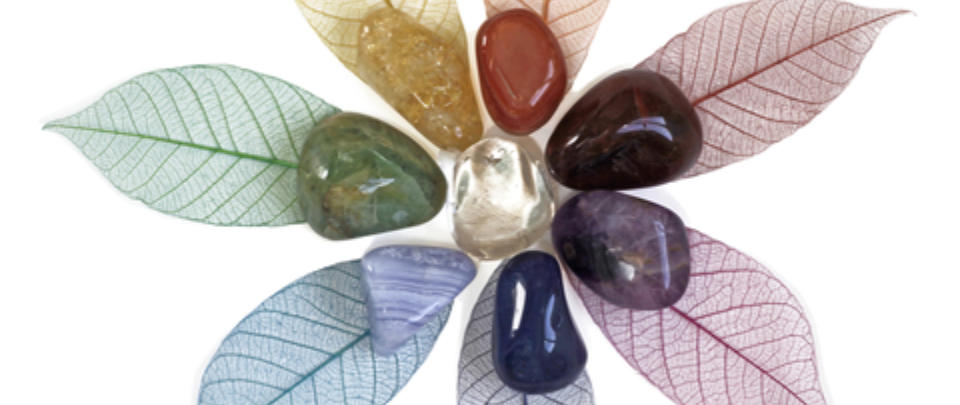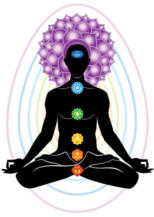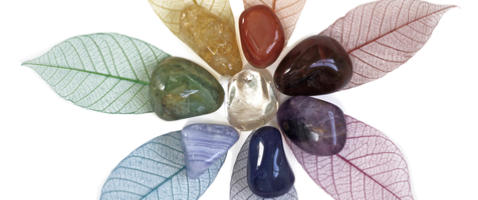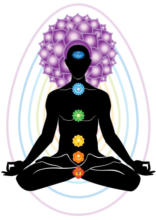

Chakras
What are Chakras?
Chakra is a Sanskrit word that translates roughly to “wheel” in English. There are hundreds of chakras within our subtle bodies, and each is a small energy center (similar to a vortex) that connects us to the rest of the Universe. I personally prefer to work with the chakra system (as opposed to the meridian system) mainly because I was dealing with chakras long before I became involved with Energetic Healing. I begin each of my healing sessions by clearing and balancing the client’s chakras. Most people only deal with (or may only be aware of) the seven major chakras (depicted in the diagram on the right below) and I’m only going to describe those here. Next to the graphic I’ve listed the number, English name, and identity for each of the seven main chakras: 7th chakra - Crown “I understand” 6th chakra - Third Eye “I see” 5th chakra - Throat “I speak” 4th chakra - Heart “I love” 3rd chakra - Solar Plexus “I do” 2nd chakra - Sacral “I feel” 1st chakra - Root “I am” While they can affect our health, the chakras aren’t a part of the physical body … they are connected to the energetic and emotional bodies (sometimes referred to as the “subtle bodies”) that are entwined with the physical body. Like the meridian system, each chakra is associated with certain organs in the body. But they are also associated with particular emotional states and mental actions. Below I’ve given a brief description of the chakras and their emotional associations as well as how an under/over-active chakra may manifest itself in our behavior. Muladhara … the Root Chakra. The root chakra sits below the base of the spine (near the tip of the coccyx). It is associated with the adrenal glands and immune system. This chakra keeps us grounded to the Earth and helps keep us stable (physically and emotionally). An over-active root chakra can manifest as greed or materialism … an under-active root chakra can cause fear or nervousness. Svadhistnana … the Sacral Chakra. The sacral chakra is midway between the pelvic bone and navel. It is associated with the reproductive organs. This chakra affects the emotions and creativity. An over-active sacral chakra may lead to addictions or being overly emotional … an under-active sacral chakra can leave one apathetic or emotionally “numb”. Manipura … the Solar Plexus Chakra. The solar plexus chakra is located near the physical solar plexus in the body. It is associated with the spleen and pancreas. This chakra deals with self-esteem and personal power. An over-active solar plexus chakra may be responsible for overly aggressive or domineering behavior … an under-active solar plexus chakra can result in poor self-esteem or overly timid behavior. Anahata … the Heart Chakra. The heart chakra is located near the heart and lungs around the center of the sternum. It is associated with the heart and thymus. This chakra deals with love and trust. An over-active heart chakra may result in clingy or smothering behavior toward others … an under-active heart chakra may cause cold or distant behavior toward others. Vishuddha … the Throat Chakra. The throat chakra is located about midway up the neck. It is associated with the thyroid. This chakra affects truth in communication. An over-active throat chakra can be responsible for talking too much without listening or dominating conversations or situations … an under-active throat chakra may result in a lack of communication. It should be noted that not speaking the truth can result in this chakra becoming blocked. Ajna … the Third-Eye Chakra. The third-eye chakra is located in the center of the forehead. It is associated with the pituitary gland. This chakra influences our insight and intuition. An over-active third-eye chakra can lead to spending too much time in fantasy worlds, nightmares, or even hallucinations … an under-active third-eye chakra may result in thinking that is too rigid, denial of reality, or confusion. Sahasrara … the Crown Chakra. The crown chakra is located at the top of the head in the center. It is associated with the pineal gland. This chakra deals with wisdom and spiritual peace. An over-active crown chakra can result in too much intellectualizing or a mental detachment from the body or spirit … an under-active crown chakra can lead to spiritual apathy/uncertainty or excessive materialism. For those who may be interested, the table below lists some additional information for the seven main chakras: I also deal with additional chakras, especially what I call the “extended chakras”, that connect us with the Earth and the spiritual energies of the Universe. I usually also clear and balance the six extended chakras prior to working on other areas within a client’s energetic body; if/when I come across any of the smaller chakras that need clearing out, I take care of those too.
For Educational purposes only.
This information has not been evaluated by a medical professional.
This information is not intended to diagnose, treat, cure, or prevent any disease.










[Home] [Energetic Healing] [Energetic Healing Benefits] [Distance Sessions] [Energetic Healing for Animals] [Chakras] [Crystals] [Sound]
[Aromatherapy] [Light Language] [Astrology] [About] [Philosophy] [Healing with Energy] [Energetic Bodies] [Spaces] [Reiki] [Testimonials]
[Prices] [Policies] [Ethics] [Links] [Contact] [Online Shop] [FAQ] [Site Map]
Chakra
Sanskrit and
English Names
Musical
Note
Color
Element
Chant
Association
Conditions
7th
Sahasrara /
Crown
B
Violet or
White
Spirit
AH
Wisdom /
Spiritual Peace
Right to Know
6th
Ajna /
Third Eye
A
Indigo
Light
OM
Insight and
Intuition
Right to See
5th
Vishuddha /
Throat
G
Blue
Sound
HAM
Truth in
Communication
Right to Speak /
Hear Truth
4th
Anahata /
Heart
F
Green
Air
YAM
Love and Trust
Right to Love /
Be Loved
3rd
Manipura /
Solar Plexus
E
Yellow
Fire
RAM
Self-esteem and
Personal Power
Right to Act
2nd
Svadhistnana /
Sacral
D
Orange
Water
VAM
Emotions and
Creativity
Right to Feel
1st
Muladhara /
Root
D
Red
Earth
LAM
Survival / Self
Preservation
Right to Exist

![Copyright © 2013 - 2025 Healing Through Balance, LLC. [Home] [Energetic Healing] [Energetic Healing Benefits] [Distance Sessions] [Energetic Healing for Animals] [Chakras] [Crystals] [Sound] [Aromatherapy] [Light Language] [Astrology] [About] [Philosophy] [Healing with Energy] [Energetic Bodies] [Spaces] [Reiki] [Testimonials] [Prices] [Policies] [Ethics] [Links] [Contact] [Online Shop] [FAQ]](index_html_files/45716.png)
For Educational purposes only.
This information has not been evaluated by a medical professional.
This information is not intended to diagnose, treat, cure, or prevent any disease.
Chakras
What are Chakras?
Chakra is a Sanskrit word that translates roughly to “wheel” in English. There are hundreds of chakras within our subtle bodies, and each is a small energy center (similar to a vortex) that connects us to the rest of the Universe. I personally prefer to work with the chakra system (as opposed to the meridian system) mainly because I was dealing with chakras long before I became involved with Energetic Healing. I begin each of my healing sessions by clearing and balancing the client’s chakras. Most people only deal with (or may only be aware of) the seven major chakras (depicted in the diagram below) and I’m only going to describe those here. Below the graphic I’ve listed the number, English name, and identity for each of the seven main chakras: 7th chakra - Crown “I understand” 6th chakra - Third Eye “I see” 5th chakra - Throat “I speak” 4th chakra - Heart “I love” 3rd chakra - Solar Plexus “I do” 2nd chakra - Sacral “I feel” 1st chakra - Root “I am” While they can affect our health, the chakras aren’t a part of the physical body … they are connected to the energetic and emotional bodies (sometimes referred to as the “subtle bodies”) that are entwined with the physical body. Like the meridian system, each chakra is associated with certain organs in the body. But they are also associated with particular emotional states and mental actions. Below I’ve given a brief description of the chakras and their emotional associations as well as how an under/over-active chakra may manifest itself in our behavior. Muladhara … the Root Chakra. The root chakra sits below the base of the spine (near the tip of the coccyx). It is associated with the adrenal glands and immune system. This chakra keeps us grounded to the Earth and helps keep us stable (physically and emotionally). An over-active root chakra can manifest as greed or materialism … an under-active root chakra can cause fear or nervousness. Svadhistnana … the Sacral Chakra. The sacral chakra is midway between the pelvic bone and navel. It is associated with the reproductive organs. This chakra affects the emotions and creativity. An over-active sacral chakra may lead to addictions or being overly emotional … an under- active sacral chakra can leave one apathetic or emotionally “numb”. Manipura … the Solar Plexus Chakra. The solar plexus chakra is located near the physical solar plexus in the body. It is associated with the spleen and pancreas. This chakra deals with self- esteem and personal power. An over-active solar plexus chakra may be responsible for overly aggressive or domineering behavior … an under- active solar plexus chakra can result in poor self- esteem or overly timid behavior. Anahata … the Heart Chakra. The heart chakra is located near the heart and lungs in the center of the sternum. It is associated with the heart and thymus. This chakra deals with love and trust. An over-active heart chakra may result in clingy or smothering behavior toward others … an under- active heart chakra may cause cold or distant behavior toward others. Vishuddha … the Throat Chakra. The throat chakra is located about midway up the neck. It is associated with the thyroid. This chakra affects truth in communicating. An over-active throat chakra can be responsible for talking too much without listening or dominating conversations or situations … an under-active throat chakra may result in a lack of communication. It should be noted that not speaking the truth can result in this chakra becoming blocked. Ajna … the Third-Eye Chakra. The third-eye chakra is located in the center of the forehead. It is associated with the pituitary gland. This chakra influences our insight and intuition. An over-active third-eye chakra can lead to spending too much time in fantasy worlds, nightmares, or even hallucinations … an under-active third-eye chakra may result in thinking that is too rigid, denial of reality, or confusion. Sahasrara … the Crown Chakra. The crown chakra is located at the top of the head in the center. It is associated with the pineal gland. This chakra deals with wisdom and spiritual peace. An over-active crown chakra can result in too much intellectualizing or a mental detachment from the body or spirit … an under-active crown chakra can lead to spiritual apathy/uncertainty or excessive materialism. For those who may be interested, the table below lists some additional information for the seven main chakras: I also deal with additional chakras, especially what I call the “extended chakras”, that connect us with the Earth and the spiritual energies of the Universe. I usually also clear and balance the six extended chakras prior to working on other areas within a client’s energetic body; if/when I come across any of the smaller chakras that need clearing out, I take care of those too.








Chakra
Sanskrit and
English
Names
Musical
Note
Color
Element
Chant
Association
Conditions
7th
Sahasrara /
Crown
B
Violet
or
White
Spirit
AH
Wisdom /
Spiritual Peace
Right to
Know
6th
Ajna /
Third Eye
A
Indigo
Light
OM
Insight and
Intuition
Right to
See
5th
Vishuddha /
Throat
G
Blue
Sound
HAM
Truth in
Communication
Right to
Speak /
Hear Truth
4th
Anahata /
Heart
F
Green
Air
YAM
Love and Trust
Right to
Love / Be
Loved
3rd
Manipura /
Solar Plexus
E
Yellow
Fire
RAM
Self-esteem
and Personal
Power
Right to Act
2nd
Svadhistnana /
Sacral
D
Orange
Water
VAM
Emotions and
Creativity
Right to
Feel
1st
Muladhara /
Root
D
Red
Earth
LAM
Survival / Self
Preservation
Right to
Exist











